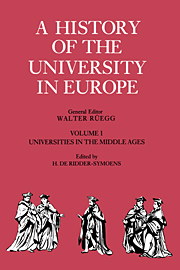Book contents
- Frontmatter
- Contents
- List of maps
- Contributors and editors
- Reader's guide
- Bibliographical abbreviations used in notes
- FOREWORD
- Acknowledgements
- PART I THEMES AND PATTERNS
- PART II STRUCTURES
- PART III STUDENTS
- PART IV LEARNING
- THE FACULTY OF ARTS
- EPILOGUE
- Editors' note on the indexes
- Name index
- Geographical and subject index
FOREWORD
- Frontmatter
- Contents
- List of maps
- Contributors and editors
- Reader's guide
- Bibliographical abbreviations used in notes
- FOREWORD
- Acknowledgements
- PART I THEMES AND PATTERNS
- PART II STRUCTURES
- PART III STUDENTS
- PART IV LEARNING
- THE FACULTY OF ARTS
- EPILOGUE
- Editors' note on the indexes
- Name index
- Geographical and subject index
Summary
The university as a european institution
The university is a European institution; indeed, it is the European institution par excellence. There are various reasons for this assertion.
As a community of teachers and taught, accorded certain rights, such as administrative autonomy and the determination and realization of curricula (courses of study) and of the objectives of research as well as the award of publicly recognized degrees, it is a creation of medieval Europe, which was the Europe of papal Christianity. This is shown in the first volume of our history.
It is, moreover, the only European institution which has preserved its fundamental patterns and its basic social role and functions over the course of history; it has indeed been strengthened and extended in these respects – as the four volumes will show. Of the three acknowledged powers of medieval European society – regnum, sacerdotium, and studium – the first, political power, has undergone profound changes. The second has, in the Roman Catholic Church, preserved its structure and expanded over the whole planet but it has lost the monopoly which it once possessed of providing the conditions of salvation. The same may be said for the other institutional and cultural creations of the Middle Ages, i.e. the distinctively European forms of organization of a money economy, the plastic arts, architecture, and music.
No other European institution has spread over the entire world in the way in which the traditional form of the European university has done. The degrees awarded by European universities – the bachelor's degree, the licentiate, the master's degree, and the doctorate – have been adopted in the most diverse societies throughout the world.
- Type
- Chapter
- Information
- A History of the University in Europe , pp. xix - xxviiPublisher: Cambridge University PressPrint publication year: 1991
- 3
- Cited by



